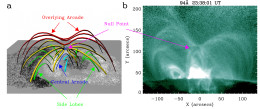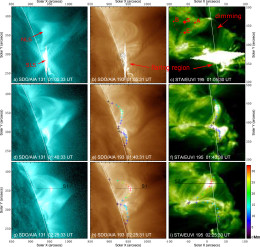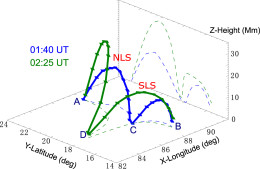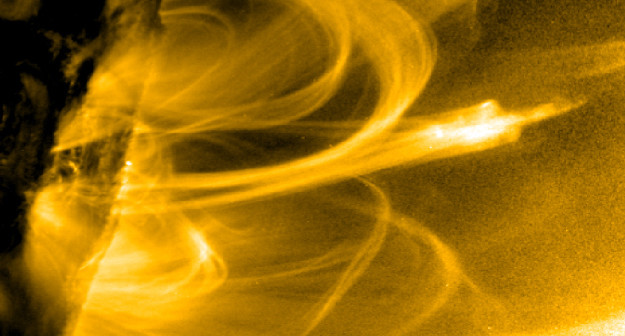Because the Sun is so close, it makes an excellent laboratory to study processes we can’t examine in distant stars. One open question is that of how solar magnetic fields rearrange themselves, producing the tremendous releases of energy we observe as solar flares and coronal mass ejections (CMEs).
What is Magnetic Reconnection?
Magnetic reconnection occurs when a magnetic field rearranges itself to move to a lower-energy state. As field lines of opposite polarity “reconnect”, magnetic energy is suddenly converted into thermal and kinetic energy.
This process is believed to be behind the sudden releases of energy from the solar surface in the form of solar flares and CMEs. But there are many different models for how magnetic reconnection could occur in the magnetic field at the Sun’s surface, and we aren’t sure which one of these reconnection types is responsible for the events we see.
Recently, however, several studies have been published presenting some of the first observational support of specific reconnection models. Taken together, these observations suggest that there are likely several different types of reconnection happening on the solar surface. Here’s a closer look at two of these recent publications:

A pre-eruption SDO image of a flaring region (b) looks remarkably similar to a 3D cartoon for typical breakout configuration (a). Click for a closer look! [Adapted from Chen et al. 2016]
Study 1: Magnetic Breakout
Led by Yao Chen (Shandong University in China), a team of scientists has presented observations made by the Solar Dynamics Observatory (SDO) of a flare and CME event that appears to have been caused by “magnetic breakout”.
In the magnetic breakout model, a series of loops in the Sun’s lower corona are confined by a surrounding larger loop structure — called an arcade — higher in the corona. As the lower loops push upward, reconnection occurs in the upper corona, removing the overlying, confining arcade. Without that extra confinement, the lower coronal loops expand upward, erupting from the solar surface.

Snapshots from the SDO side view (left and center) and STEREO overhead view (right). The three rows show the time evolution of the double-loop structure after the initial flare. In the STEREO view, you can see the central footpoints of the loops slip to the left. [Gou et al. 2016]
Study 2: Slipping Reconnection
A team of scientists from the University of Science and Technology of China, led by Tingyu Gou and Rui Liu, have presented the first stereoscopic observation of “slipping reconnection” in the Sun, made by the two-spacecraft Solar Terrestrial Relations Observatory (STEREO).
In slipping reconnection, magnetic field lines continuously exchange connectivities with their neighbors, causing them to slip through plasma. Observations by STEREO of a flaring double-loop system revealed that the central footpoints — the endpoints where the loops are anchored to the solar surface — slipped sideways after a flare.

The authors’ model of the double-loop structure at two different times, during which the central footpoint slips from point C to D. Projections onto the XY and YZ planes show STEREO’s and SDO’s views, respectively. [Gou et al. 2016]
Double Bonus
Check out the videos below to watch these processes happen!
This first video is from Chen et al. 2016, and shows the SDO view of coronal loops in three wavelengths. If you watch carefully, you can see the sequential brightening of loops — signs of the breakout reconnection — before the flare and CME.
This second video is from Gou et al. 2016, and shows the SDO side view (left and center panels) and STEREO top view (right panel) of a flare and the slipping reconnection that occurred after. Keep your eye on the STEREO view between 0:02 and 0:04 to watch the central footpoint slide left.
Citation
Yao Chen et al 2016 ApJ 820 L37. doi:10.3847/2041-8205/820/2/L37
Tingyu Gou et al 2016 ApJ 821 L28. doi:10.3847/2041-8205/821/2/L28


1 Comment
Pingback: Por que a atmosfera do sol é mais quente do que a sua superfície? | Dicas e Curiosidades™